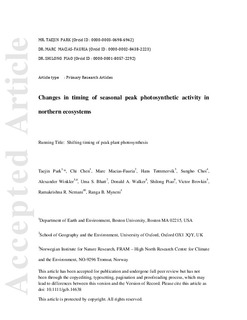Changes in timing of seasonal peak photosynthetic activity in northern ecosystems
Park, Taejin; Chen, Chi; Macias-Fauria, Marc; Tømmervik, Hans; Choi, Sungho; Winkler, Alexander; Bhatt, Uma S.; Walker, Donald A.; Piao, Shilong; Brovkin, Victor; Nemani, Ramakrishna R.; Myneni, Ranga B.
Journal article, Peer reviewed
Accepted version

Åpne
Permanent lenke
http://hdl.handle.net/11250/2597591Utgivelsesdato
2019Metadata
Vis full innførselSamlinger
- Publikasjoner fra CRIStin - NINA [2364]
- Scientific publications [1392]
Originalversjon
10.1111/gcb.14638Sammendrag
Seasonality in photosynthetic activity is a critical component of seasonal carbon, water and energy cycles in the Earth system. This characteristic is a consequence of plant’s adaptive evolutionary processes to a given set of environmental conditions. Changing climate in northern lands (>30°N) alters the state of climatic constraints on plant growth, and therefore, changes in the seasonality and carbon accumulation are anticipated. However, how photosynthetic seasonality evolved to its current state, and what role climatic constraints and their variability played in this process and ultimately in carbon cycle is still poorly understood due to its complexity. Here, we take the ‘laws of minimum’ as a basis and introduce a new framework where the timing (Day of Year) of peak photosynthetic activity (DOYPmax) acts as a proxy for plant’s adaptive state to climatic constraints on its growth. Our analyses confirm that spatial variations in DOYPmax reflect spatial gradients in climatic constraints as well as seasonal maximum and total productivity. We find a widespread warming-induced advance in DOYPmax (−1.66 ± 0.30 days decade-1, P < 0.001) across northern lands, indicating a spatio-temporal dynamism of climatic constraints to plant growth. We show that the observed changes in DOYPmax are associated with an increase in total gross primary productivity through enhanced carbon assimilation early in the growing season, which leads to an earlier phase shift in land-atmosphere carbon fluxes and an increase in their amplitude. Such changes are expected to continue in the future based on our analysis of Earth System Model (ESM) projections. Our study provides a simplified, yet realistic framework based on first principles for the complex mechanisms by which various climatic factors constrain plant growth in northern ecosystems.